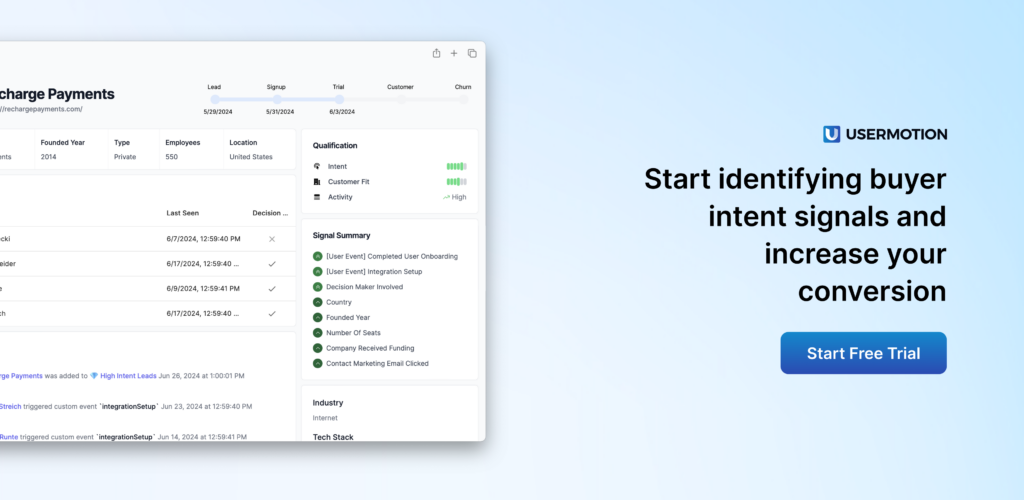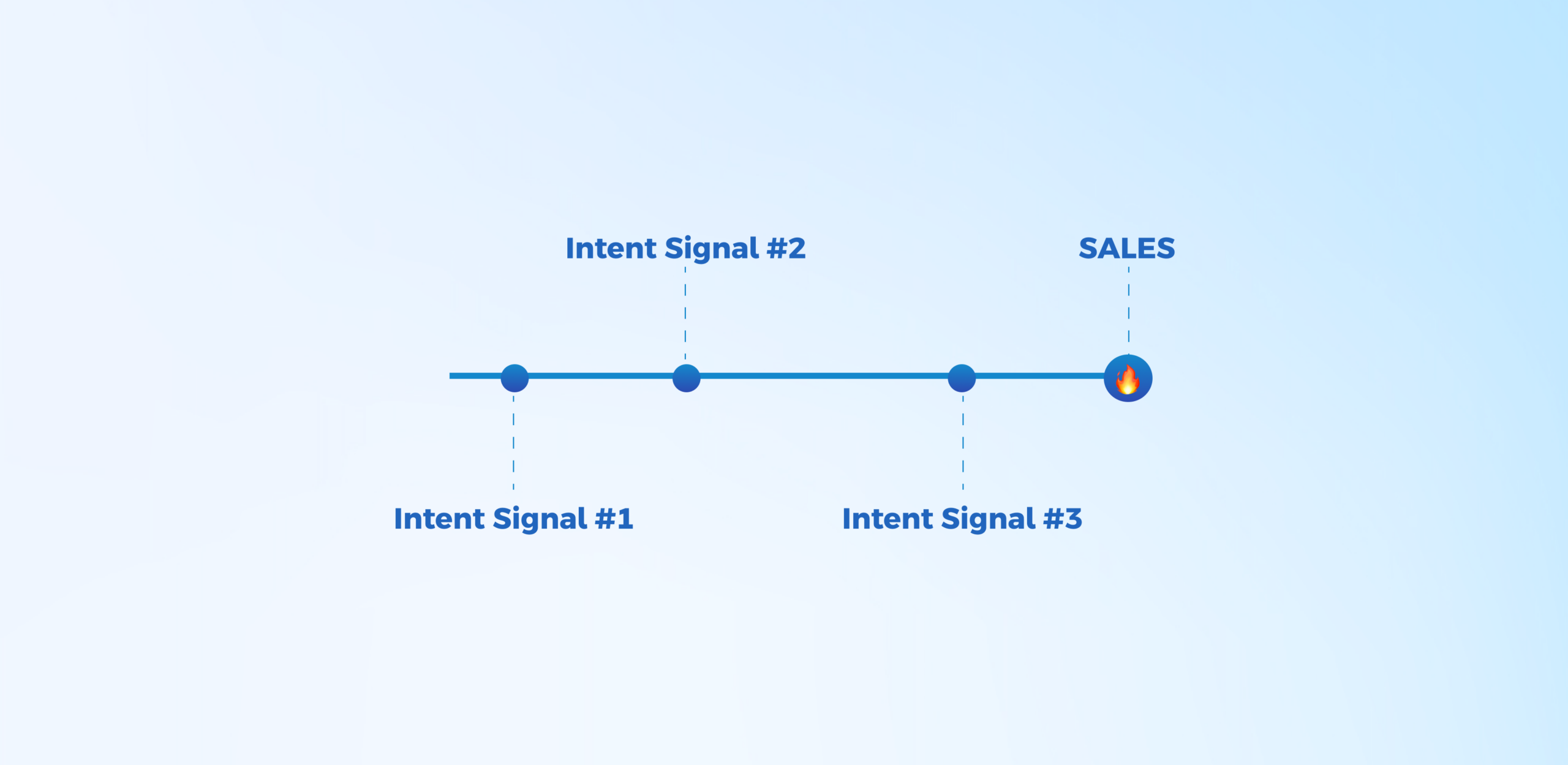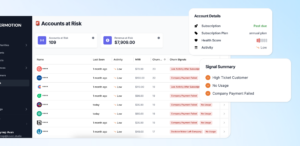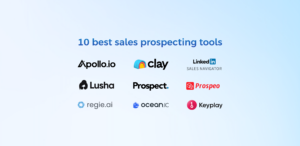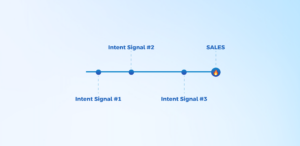Signal based selling is a strategy to identify the signals that show buying intent and acquire qualified leads for your sales. Let’s talk about those signals in this post and how to prioritize them from high to low.
Signal Based Selling is All About Signals of Intent
Signal-based selling focuses on identifying and interpreting various signals of intent to effectively target and engage potential customers.
By recognizing these signals, sales teams can prioritize their efforts on leads that are more likely to convert, thus optimizing their sales process and improving overall success rates.
This method relies on tracking and analyzing specific behaviors and events that indicate a prospect’s readiness to buy, ensuring that sales efforts are timely and relevant.
10 Signal Based Selling Signals
1. Product Signals
These signals revolve around how customers interact with your product.
Look for accounts that are reaching consumption ceilings, surges in product activity, new integrations, and when new users are invited to a workspace.
These indicate that the customer is finding value in the product and might be ready to purchase or upgrade.
✅ Expenditure peaks: Indicates that customers are maximizing their current plans and signals potential upgrade readiness.
✅ Surges in product activity: Shows increased usage, suggesting the customer is finding more value and may be ready to invest further.
✅ New integrations: Highlights new use cases, indicating growing reliance on your product.
✅ New users invited: Reflects expansion within the organization, signaling deeper engagement and potential for upselling.
✅ Feature adoption: Tracks when customers start using new features, suggesting growing interest and satisfaction.
2. Employment Activity
Beyond the obvious signals like job changes, look for promotions, layoffs, and open roles.
Promotions can indicate a desire to make an impact with new tools, layoffs might necessitate technology to fill gaps, and open roles can highlight resource needs that your product could fulfill.
✅ Promotions: Newly promoted individuals may look for impactful tools to prove their value.
✅ Layoffs: Companies may seek technology to maintain productivity with fewer employees.
✅ New hires: Indicates growth and potential need for more tools or licenses.
✅ Open positions: Highlights resource gaps your product can fill.
✅ Executive appointments: Signals potential for strategic changes and new tool adoptions.
3. Expiration Dates
This includes any deadlines tied to product usage, such as free trial periods or upcoming renewals.
Reaching out just after a trial ends can be effective, especially if you offer an incentive like an extended trial period.
Additionally, knowing competitors’ renewal dates can help you time your outreach to coincide with their evaluation of alternatives.
✅ End offFree trials: Key moment to convert users who have experienced the product’s value.
✅ Subscription renewals: Critical time to engage customers before they decide to continue or cancel their service.
✅ Contract expirations: Opportunity to negotiate new terms or upgrades.
✅ Competitor renewal dates: Timely chance to present your product as a superior alternative.
✅ License expirations: Moment to propose renewals or additional licenses to support growing usage.
4. Cries for Help
These come from public forums, review sites, and support forums where users express frustrations or seek help.
Monitoring sites like Stack Overflow, Reddit, and G2 can provide insights into pain points that your product can solve.
Reaching out to users who express dissatisfaction with competitors can be particularly fruitful.
✅ Support forum complaints: Direct indication of pain points your product can solve.
✅ Negative reviews: Signals dissatisfaction with competitors, presenting a chance to offer a better solution.
✅ Feature requests: Highlights unmet needs that your product might fulfill.
✅ Bug reports: Indicates active use and potential for product improvement discussions.
✅ Help desk inquiries: Demonstrates users’ engagement and potential need for more advanced solutions.
5. Developer Signals
Specific to companies selling to developers, GitHub activities such as liking open-source software, collaborating on code, or reporting bugs can indicate interest in a commercial offering.
Signals from open-source communities can highlight potential leads for your products or services.
Forking Repositories: Shows deep interest and engagement with the project, indicating potential for commercial interest.
✅ Issue tracking: Involvement in problem-solving suggests a need for robust solutions.
✅ Pull requests: Active contributions imply significant usage and reliance on the software.
✅ Starred projects: Indicates popularity and user interest that can be leveraged for sales.
✅ Code reviews: Reflects collaborative effort and possible need for advanced tools.
6. Changes in Legislation or Policies
New regulations or changes in platform usage policies can drive demand for specific solutions. For example, GDPR compliance led to increased sales of security and compliance software.
Upcoming changes in email regulations might prompt users to seek new solutions for their email marketing needs.
✅ GDPR compliance: Necessitates new tools for data protection and privacy management.
✅ Platform API changes: Forces companies to seek compatible solutions quickly.
✅ Email regulation updates: Prompts need for compliant email marketing tools.
✅ Tax law changes: Drives demand for updated financial software.
✅ Industry-specific regulations: Creates niche opportunities for tailored solutions.
7. Activity from VIPs
Engagement from high-level executives, economic buyers, or roles in security, IT, or procurement can signal serious consideration of your product. These roles typically indicate higher contract values and a greater likelihood of closing a deal.
✅ CEO engagement: High-level interest suggests serious consideration and potential for large deals.
✅ CFO queries: Indicates budget considerations for your product.
✅ IT manager activity: Reflects interest in integration and technical feasibility.
✅ Security officer interest: Shows concern for compliance and security, crucial for high-value contracts.
✅ Procurement officer interaction: Suggests impending purchase decisions and final evaluations.
8. Tech Stack Activity
Changes in a company’s technology stack, such as adding or removing software, can be telling.
If a company adds a complementary technology to your product, it might be a good time to highlight how your solutions can work together.
Conversely, removing a product might indicate dissatisfaction and openness to alternatives.
✅ New software implementations: Opportunities to offer complementary solutions.
✅ Removal of existing tools: Indicates potential dissatisfaction and openness to alternatives.
✅ Integration with major platforms: Suggests readiness for advanced integrations and solutions.
✅ Switching analytics tools: Reflects need for better insights and possibly new analytics tools.
✅ Adoption of competitor software: Signals potential to offer a better or complementary solution.
9. Company Milestones
Events like new product launches, acquisitions, and new leadership can signal opportunities.
New products often need marketing and analytics support, acquisitions require integration tools, and new leadership may bring initiatives that align with your solutions.
✅ Product launches: Need for marketing, analytics, and support tools.
✅ Acquisitions: Integration challenges that your product can solve.
✅ New leadership: Potential for strategic shifts and new tool adoptions.
✅ Expansion into new markets: Indicates need for scalable and versatile solutions.
✅ Opening new offices: Opportunities for infrastructure and operational tools.
10. Website Activity
Beyond just visits to your pricing page, track deeper engagement such as time spent on the page, interactions with pricing calculators, and visits to integration or documentation pages.
These behaviors often indicate high intent and readiness to engage with your sales team.
✅ Pricing page interactions: Indicates strong purchase intent.
✅ Time spent on key pages: Reflects high interest and potential readiness to buy.
✅ Engagement with calculators: Shows active consideration of your pricing plans.
✅ Documentation searches: Suggests deep interest in product capabilities.
✅ Integration page visits: Indicates consideration of how your product fits into their tech stack.
How to Prioritize These Signals?
To effectively prioritize these signals, you need to evaluate them based on their likelihood to indicate a prospect’s readiness to buy and their potential impact on your sales targets. Here’s how you can prioritize them from high to low:
1. High-Intent Signals 🔥
- Product Signals: Direct interactions with your product often indicate immediate interest and readiness to purchase.
- Expiration Dates: Imminent deadlines such as trial expirations or contract renewals require timely engagement to convert or upsell.
- Activity from VIPs: Engagement from high-level decision-makers typically signifies serious consideration and potential for larger deals.
2. Moderate-Intent Signals 🧲
- Website Activity: Deep engagement on key pages suggests significant interest but may require further qualification.
- Employment Activity: Job changes, promotions, and new hires indicate potential changes in buying needs but might not lead to immediate purchases.
- Company Milestones: Events like product launches or acquisitions can create opportunities but may not always indicate urgent buying intent.
3. Low-Intent Signals 🪫
- Cries for Help: Indications of dissatisfaction or need for assistance can highlight potential leads but may require nurturing.
- Developer Signals: Engagement in developer communities shows interest but might need more time to convert into sales.
- Changes in Legislation or Policies: Regulatory changes can drive demand but often lead to longer sales cycles.
- Tech Stack Activity: Changes in a company’s technology stack indicate openness to new solutions but may need additional context to assess immediate buying intent.
Identify Signal Based Selling Signals with UserMotion
UserMotion is a platform that helps you identify intent signals by analyzing data from multiple sources, including data warehouses.
By seamlessly integrating with your existing data infrastructure, UserMotion can pull in relevant data points, revealing critical intent signals.
Here’s how UserMotion enhances your signal-based selling strategy:
• Data Aggregation: UserMotion collects data from various sources such as CRM systems, marketing automation tools, and customer support platforms to create a comprehensive view of customer interactions.
- Intent signals identification: The platform uses algorithms to analyze the aggregated data and identify key intent signals based on user behaviors and interactions.
- Lead scoring: UserMotion scores leads based on the identified signals, helping you prioritize those with the highest potential for conversion.
- High-potential prioritization: By evaluating the strength and relevance of each signal, UserMotion enables sales teams to focus on high-intent leads, ensuring efficient and effective outreach.
